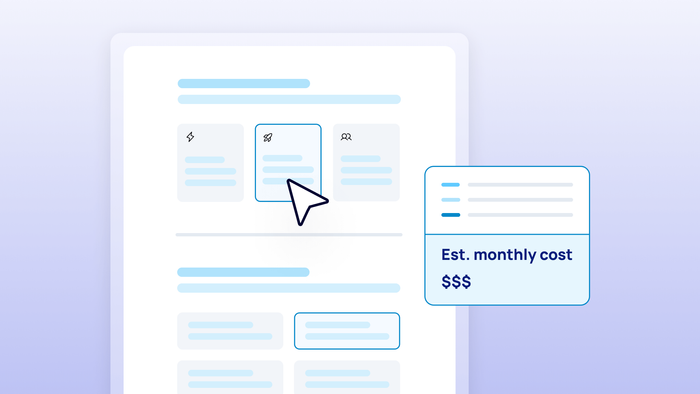Bubble’s mission is to make app development more approachable and accessible for everyone. While many other, simpler no-code tools focus only on one aspect of development, Bubble is full-stack — meaning we also take care of the backend infrastructure services you need to host your app, like the server, database, storage, network, and security.
With traditional full-stack development — as in writing code — a lot of time and resources go into managing backend services and their costs. (Case in point: There’s an entire industry dedicated to helping companies manage cloud spend.) But at Bubble, we simplify the process by folding all those details into workload.
Workload combines all the server resources needed to host, run, and scale any app built on Bubble into one metric — workload units (WU) — that you can monitor and manage. Unlike “capacity” (our legacy usage metric), workload isn’t a shared resource across all Bubble apps, and it doesn’t limit your app’s speed. Instead, workload is only concerned with your app’s resource usage, and you can use more or less of it as needed. In other words, capacity was a speed limit on the highway, whereas workload is more like the fuel for your car — and you get to decide how much to put in the tank.
But in order to leverage workload and scale seamlessly, we know you need the right tools to understand, track, and optimize your app’s workload usage. Here’s a roundup of all the existing and new workload management resources that have launched recently. (And stay tuned for even more updates in the coming months.)
Learn more about workload with new resources and tools
New and improved workload articles in the Bubble Manual
To help explain workload top to bottom, we created a one-stop shop in the Bubble Manual. We recently reorganized the workload section and added new articles categorized by understanding, tracking, and optimizing workload so it’s easier to find the most helpful materials.
This collection of resources lives in the Bubble Manual for easy access anytime. From understanding the workload calculation to the top workload optimization opportunities, it’s all there.
Prepare with the plan migration tool
If you have an app on a legacy monthly plan, we just launched a plan migration tool to help you understand your future plan and workload configuration. Your plan will be auto-migrated on October 1, 2024 at 12 AM UTC, but you can also manually migrate before this date. Based on your workload usage from the last calendar month, the tool will also clarify if your app will need workload add-ons: keeping pay-as-you-go workload overages enabled and/or subscribing to a workload subscription tier for a volume discount.
Track workload with app metrics and custom alerts
Last year, we released the app metrics tab to help track historical workload usage. The charts provide an overview of your app’s total workload and offer ways to drill down into each activity to get a granular look at how workflows, actions, and expressions are impacting costs.
We’re now excited to introduce new custom workload notifications to help you stay informed about your app’s workload consumption. You can specify a custom workload threshold in the notifications tab of your app settings to set up an email alert. When your app hits that threshold, we’ll send you an email so you can make any desired changes — like pausing or updating workflows or changing your workload subscription.
Tips and features to optimize workload
Workload optimization tips
By measuring which app processes are using resources, workload also helps you identify optimization opportunities. Over the past year, we’ve released new resources and tools that help you maintain workload efficiency.
Besides this workload optimization guide published in April 2023, the Bubble Manual is also an incredible resource. We recently added new materials to the refreshed articles in the Bubble Manual, as mentioned earlier — including optimization tips from Bubble agencies Minimum Studio, Neam, and Support Dept that detail how they’ve helped clients decrease workload by as much as 400%.
Features to help you save on workload
Reading about workload optimizations is one thing — implementing them is another. We’ve been hard at work on platform improvements that help you build smart and rest assured that your app is humming along efficiently:
- A new way to complete bulk data operations: Many of you use recursive workflows to complete bulk data operations, but there’s an even more efficient solution available to users on workload-based plans: schedule API workflow on a list (SAWOL). Our team made major investments in the feature to make it easier to configure, 3X faster, and more scalable (up to 100,000 items).
- Run bulk operations without impacting your end users: To prevent bulk operations from affecting your app’s user experience, we separated frontend and backend processes so that we can manage them separately. This isolation allows us to prevent background tasks from degrading performance for your users interacting with your app’s frontend. It also improves reliability and speed for bulk workflow execution.
- Infinite recursion protection: The most common cause of accidental workload spikes is a runaway recursive workflow. Infinite recursion protection lets you set an app-level limit for recursive workflows in the API tab in your app settings, even if you forget to add a workflow-level constraint. As of July 1, 2024, all new Bubble apps will have this feature enabled with a default limit of 10. Apps created before July 1 won't have any limit applied automatically, but you can enable and customize the limit any time.
Everything you need to build powerfully and efficiently
Our workload tools and resources were created to help your apps continue scaling — but we’re not stopping here. In the next few months, we’re releasing a new workload-related video course on YouTube and even more improvements to help you understand, track, and optimize your workload.
Build quickly without managing a traditional infrastructure system, while scaling confidently knowing your app has the resources to keep pace with demand, and stay cost-efficient by only paying for what you need, when you need it.
Build for as long as you want on the Free plan. Only upgrade when you're ready to launch.
Join Bubble






